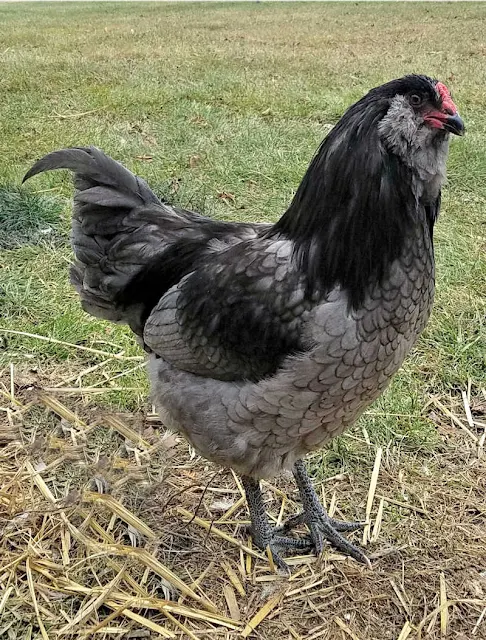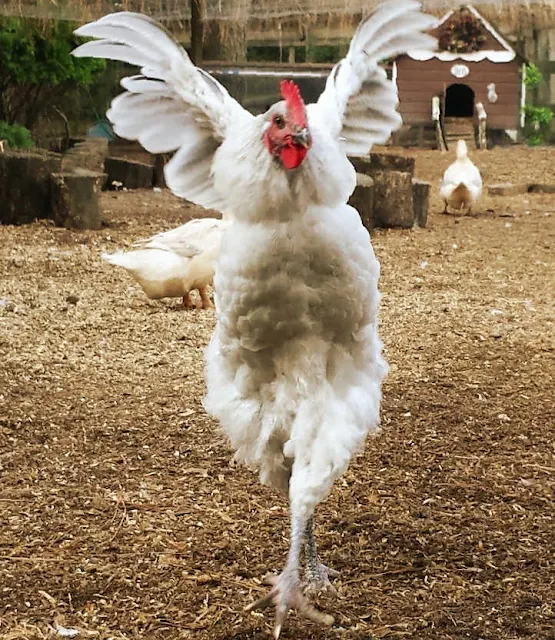Lessons Learned about Roosters
There are honestly many pros and cons to having a rooster in your chicken flock. So I'm sharing some of the lessons I've learned personally about keeping roosters over the past decade or so.
Roosters aren't for everyone or every flock. It's a very personal decision whether or not to keep a rooster.
And for much of our time raising chickens, the only roosters we've had in our flock are those that we hatched (since it's pretty much impossible to control the gender of the chicks) or those that were supposed to be females, but weren't.
Even when you order female chicks or pick them out from your feed store, they're only 90% guaranteed to be female. So mistakes happen.
We had been keeping chickens for several years, but always bought sexed female chicks so we never had any roosters. Then early one spring in 2013, we hatched our own clutch of fertilized eggs and out of 17 chicks, ten ended up being roosters.
Ten.
We obviously couldn't keep them all - the neighbors, distant as they were from us on our little farm in Virginia, would likely have organized a lynch mob to protest all the crowing and our hens would have had something to say about it too, I'm sure.
But I fortunately was able to find good homes for all of them pretty quickly. All except for an Olive Egger rooster named John Quincy Adams.
In the ten months we had him before also finding a home for him (and from the various other roosters I've inadvertently ended up with over the years), I have learned a lot by observing the roosters and their interactions with the hens. Here are some of the lessons learned about roosters.
Lessons Learned about Roosters
You don't need a rooster for your hens to lay eggs.
I actually already knew that, but it bears emphasizing because it's a question I get asked all the time by new chicken keepers.
Hens happily lay eggs without a rooster in residence. The only difference is that the eggs they lay won't be fertile if there's no male around. But fertile or not, they will look and taste the same, contain the same nutritional content and both are fine for eating.
The only difference is that a fertilized egg will have a white "bulls-eye" on the yolk which is the rooster's DNA material. An unfertilized egg will have only a tiny white pinhead dot which is the hen's DNA material. I had never seen the bull's eye on an egg in person before and it's pretty neat .
The rooster is not always at the top of the pecking order.
Our alpha hen, Orange Chicken, and a few others made it clear that they aren't going to give up their place in the pecking order, even for a rooster.
So John Quincy fell somewhere in the upper middle - and even slept a few rungs down on the roost each night. I've found the same with our other roosters. They fall somewhere in the pecking order. Not always at the top.
Roosters don't only crow in the morning.
It's a common misconception that roosters only crow at sunrise. That couldn't be further from the truth. Roosters crow all afternoon and into the evening too. I have heard that some roosters even crow in the dark! Fortunately John Quincy only crows during daylight hours. Which is a good thing because a rooster's crow is loud.
But the notion of hearing a roosters crow at sunup and then not again for the rest of the day is hogwash.
They'll crow pretty much all day long.
Roosters really do work to protect the flock.
When I let the hens out into the pasture, John Quincy roamed the perimeter very vigilantly and sounded an alarm if he sensed danger.
A hawk swooping would cause him to round up the hens and herd them under a bush or into the coop where they stayed while he ran into the middle of the pasture, as if offering himself up to the hawk as the sacrificial lamb.
Once the hawk decided it was no match for me, our dogs, plus John Quincy and had moved on, our rooster would give the girls the "all clear" signal to let them know it was safe to emerge.
Side note: I still won't free range our flock unsupervised, despite a rooster's presence, because many a rooster has lost his life protecting their hens and that's not a sacrifice I am willing to let the little guy take unnecessarily. No rooster is a match for a determined hawk, eagle, owl, fox, coyote or dog.
Roosters are gorgeous and regal.
I think a hen with her glossy feathers, pink comb and wattles, orange legs and feet, and bright, shiny eyes is beautiful. But roosters take the cake. Like the males of many species, the roosters are usually larger and more spectacularly colorful.
With their long tail feathers, even deeper orange legs and beaks, proud erect pose, and air of authority, a well-cared for rooster is a sight to behold. Let's face it. Roosters can be gorgeous!
But beyond their appearance, roosters just walk and stand differently than hens do. I can usually tell which chicks are roosters pretty early on just from their stance and attitude. Even at a very young age.
Roosters can be mean.
But so can hens. Hens are the original mean girls.
And the rooster isn't being mean for the sake of being mean. He takes his job seriously, and at times, even you are a threat to his flock.
Having hatched and hand-raised my roosters, I think they trusted and accepted me a lot more than they would had I acquired them at an older age, but there have been a few times when John Quincy pecked me or gone at me, spurs first.
One particular time occurred when I was trying to squirt saline into one of our hen's eyes. She was blinking and I wanted to rinse out any dust. She was squawking and putting up a fuss and John Quincy came right over and basically attacked me. But in his mind, I was hurting one of "his" girls.
We've had other roosters included Sir Lancelot, a huge White Sussex, I wouldn't turn my back on and I carried at rake into the run any time he was out to protect myself. He would attack at random and many times ripped right through my jeans and split the skin on my shins.
After him came Pierre and Dorian Gray, Walter and Emilio, all of whom were hand raised and hastily renamed once it was apparent they were roosters.
And once they hit maturity and became the devil incarnate, fortunately they all eventually found new homes at farms that wanted a flock protector or breeders who were looking for new breeding stock.
Roosters will protect the smaller and weaker members of the flock.
On the flip side, roosters will routinely break up squabbles between the hens. He'll step right in whether two hens are fighting over a treat, position on the roost or space under a bush.
p>He'll also pecks any hens who pick on our smaller, younger pullets, who have taken to hanging around him for "protection".Like a typical man, he can't stand female "drama" and makes sure there isn't any inRoosters delight in finding "tasty treasures" and calling the hens over.
I had heard about this, but never seen it first hand until we had a rooster in our flock.
When I toss treats in their run or the chickens are out free ranging, the rooster will make a high pitched, excited sound, do a sort of little happy Rumpelstiltskin dance, and then pick up a treat or seed and drop it at the feet of the special hen who he wants to have it.
It's actually very sweet and it's called "tidbitting". A mother hen will do the same thing for her baby chicks to teach them what's good to eat and what's not.
Roosters have different feed requirements than hens.
Because they lay eggs, hens expend a lot of energy and also direct some of the nutrients they eat into the eggs they lay. Therefore, they have a higher caloric requirement than roosters or non-laying hens.
Layers also need supplemental calcium to ensure strong egg shells. Feeding a good-quality layer feed will provide your hens some of the calcium they need, but doesn't contain so much that it's a problem if the roosters eat it.
Since roosters aren't laying eggs, roosters don't need as much food as hens. And they won't touch a calcium supplement like crushed oyster shell or eggshell because they don't need any more calcium than what's in the feed they eat.
That's why the calcium should always be served free-choice in a separate bowl and not mixed into the feed, so each hen can eat what she needs, and the roosters and non-layers won't eat any of it.
If roosters ingest too much calcium, it can build up in their bodies since they're not expelling it in the form of eggshells and that can lead to kidney stones and other damage - and somehow the roosters know that.
Roosters often flap their wings before crowing to push oxygen into their lungs.
Because they have very small lungs and a complicated respiratory system, and because crowing takes a lot of lung power, often a rooster will flap his wings just prior to crowing to push as much oxygen into his lungs as possible so his crow will be as long - and as loud - as possible.
Our Little Bantam Cochin Rooster, Sherman
Although I have never set out to intentionally have a rooster in our flock, we currently do have a little bantam rooster named Sherman. He's a mottled Cochin. He, like all the other roosters we've ended up with over the years, was supposed to be a girl.
We've had him for a couple of years now and since he's so small and a relatively docile breed, he doesn't do much damage to my hens, and isn't at all aggressive towards us, and so I guess he'll be sticking around as long as he remains the perfect gentleman that he's been so far.
Although his crow seems just as loud as any other rooster we've had...








































